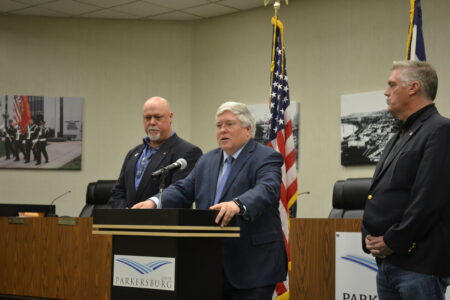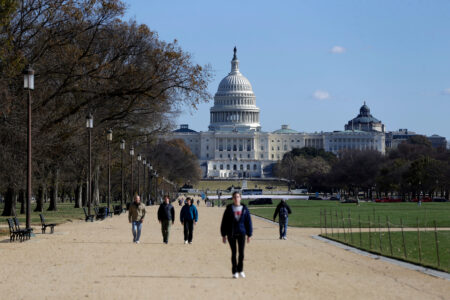West Virginia Officials Announce $4.2 Billion Investment in Energy Expected To Create More Than 4,200 Jobs

photo by: Douglass Huxley
Flanked by Del. Dave Foggin, left, and State Sen. Mike Azinger, both R-Wood, Gov. Patrick Morrisey announces in Parkersburg Thursday that the state is investing $4.2 billion into energy. Morrisey said these investments will create more than 4,200 new jobs.
PARKERSBURG — West Virginia will seek $1.44 billion from the U.S. Department of Energy to extend the useful life of six coal-fired power plants by 20 years.
Gov. Patrick Morrisey discussed the proposal in Parkersburg on Thursday while speaking about plans to invest $4.2 billion in new private sector energy, which is expected to create over 4,200 jobs.
“This is West Virginia’s comeback. West Virginia is positioned to be America’s battery, and we are going to be driving American energy independence in a way people haven’t seen before,” Morrisey said. “It’s a very exciting time, and it’s real. It’s built on the fundamentals of what’s made our state great.”
It was announced in September that the U.S. Department of Energy would implement a $625 million plan to halt the decommissioning of coal-fired power plants, retrofit and modernize the nation’s existing fleet of coal-fired plants.
“President (Donald) Trump has made driving American energy independence a center point of his new administration,” Morrisey said. “Well, we’re completely aligned with President Trump, and it’s already beginning to show.”
U.S. Secretary of Energy Chris Wright said in September it was important to keep coal-fired power plants in operation to meet the energy needs of data centers and the growing use of artificial intelligence in commerce and the daily lives of people.
“We’ve got some data centers that we think are very close to going into the end zone,” Morrisey said Thursday. “So we’re working hard on that. It’s exciting. People know that our 50 by 50 plan is very real, and it’s going to lead to so much wealth creation here in West Virginia.”
Morrisey’s 50 by 50 initiative aims to triple the state’s generation capacity to 50 gigawatts by 2050 to meet growing regional demand, particularly within the PJM grid which serves 12 other states.
“A lot of people thought it was too ambitious. It’s not ambitious. It’s going to become a reality,” Morrisey said Thursday.
Morrisey said the $4.2 billion investment included a $70 million well-plugging program creating 50 to 100 jobs, a 1.2-gigawatt energy venture with First Energy promising over 3,200 jobs and additional projects in Harrison County.
“These are jobs that are paying $75,000 per year…we know that those jobs are going to be available for the next few decades. It’s exciting,” he said.
Morrisey was joined by Del. Dave Foggin and State Sen. Mike Azinger, both R-Wood, who praised his work on the investment.
“I appreciate the governor who cares about jobs, who cares about West Virginia. And this is very exciting to me,” Azinger said. “This is what he cares about. He cares about creating jobs in West Virginia, cares about getting rid of red tape, he cares about West Virginia performing as well as it can and getting to a high performance state, where we are competing with other states for jobs.”
Foggin said he appreciated the governor’s efforts and working with the Trump administration and the state legislature to make a better place for all West Virginians.
“And I’m going to say it’s very difficult to argue with the results,” Foggin said.
Morrisey said as West Virginia expands its energy production and exports electricity nationwide, residents are expected to benefit from lower power rates.
“I care a lot about the affordability of your electric rates,” Morrisey said. “It matters, and so we have to think about that. So as we’re doing these policies, we’re trying to make sure that these investments are kind of self paying, and especially as we build out our energy production, our capacity, our transmission, that West Virginians benefit from that.”
He said these self-sustaining investments, alongside increased capacity and transmission, are designed to ensure West Virginians see real savings on their energy bills as the state leverages its growing role as a net energy exporter.
“We’re already a net exporter of electricity,” Morrisey said. “This is going to allow us to do a lot more of that, and the benefits of that get spread over West Virginia’s power bills.”





